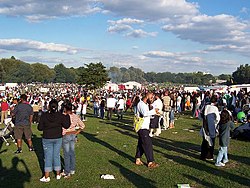This article includes a list of general references, but it lacks sufficient corresponding inline citations .(September 2010) |
| Perry Park | |
|---|---|
 The scene at the end of the Birmingham International Carnival, 7 August 2005, looking SE towards the Aldridge Road entrance. | |
 | |
| Location | Birmingham, England |
| Coordinates | 52°31′49″N1°54′20″W / 52.53033°N 1.90561°W |
| Operated by | Birmingham City Council |
Perry Park is a park in Perry Barr, Birmingham, England, at grid reference SP065925 .
Contents
The park houses Alexander Stadium and Perry Reservoir ( 52°31′55″N1°54′09″W / 52.5320°N 1.9024°W ), a small canal feeder reservoir for the Tame Valley Canal, and is bounded by the canal, the M6 motorway, the A34 and local roads. [1]
It is the venue for the end of the Birmingham International Carnival and in 2004, hosted Radio 1's final One Big Weekend under that name, with performers including Chris Moyles, Natasha Bedingfield, Lostprophets, Joss Stone and Mylo.
It is separate from the similarly named Perry Hall Park, also in Perry Barr.
The popular Birmingham BMX Track or Birmingham Bike Park is located just within the park, off the Aldridge Road entrance. [2]